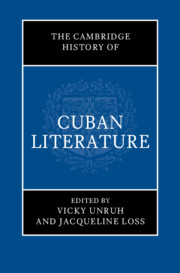Book contents
- The Cambridge History of Cuban Literature
- The Cambridge History of Cuban Literature
- Copyright page
- Dedication
- Contents
- Figures
- Contributors
- Acknowledgments
- Introduction Unfinished Histories
- Part I Literature in the Early Colony
- Part II Cuban Literature’s Long Nineteenth Century
- Part III Literary and Intellectual Culture in the Twentieth-Century Republic
- Part IV The Revolution’s Literary-Cultural Initiatives and Their Early Discontents
- 22 Beginnings
- 23 Imagining Cuba’s New Revolutionary Communities Through Film (1959–1989)
- 24 Shaping New Cultural Literacies
- 25 The Social Life of Music in Cuban Literary Culture
- 26 Casa de las Américas and Revolutionary Configurations of Latinoamericanismo
- 27 The Travels of Fiction in the Cuban Diaspora
- 28 Cuba’s Poetic Imaginary (1959–1989)
- 29 The Artistic Worlds of Guillermo Cabrera Infante
- 30 The Diasporic Odysseys of Reinaldo Arenas and His Writings
- Part V Cuba and Its Diasporas into the New Millennium
- Epilogue
- Select Bibliography
- Index
- References
26 - Casa de las Américas and Revolutionary Configurations of Latinoamericanismo
from Part IV - The Revolution’s Literary-Cultural Initiatives and Their Early Discontents
Published online by Cambridge University Press: aN Invalid Date NaN
- The Cambridge History of Cuban Literature
- The Cambridge History of Cuban Literature
- Copyright page
- Dedication
- Contents
- Figures
- Contributors
- Acknowledgments
- Introduction Unfinished Histories
- Part I Literature in the Early Colony
- Part II Cuban Literature’s Long Nineteenth Century
- Part III Literary and Intellectual Culture in the Twentieth-Century Republic
- Part IV The Revolution’s Literary-Cultural Initiatives and Their Early Discontents
- 22 Beginnings
- 23 Imagining Cuba’s New Revolutionary Communities Through Film (1959–1989)
- 24 Shaping New Cultural Literacies
- 25 The Social Life of Music in Cuban Literary Culture
- 26 Casa de las Américas and Revolutionary Configurations of Latinoamericanismo
- 27 The Travels of Fiction in the Cuban Diaspora
- 28 Cuba’s Poetic Imaginary (1959–1989)
- 29 The Artistic Worlds of Guillermo Cabrera Infante
- 30 The Diasporic Odysseys of Reinaldo Arenas and His Writings
- Part V Cuba and Its Diasporas into the New Millennium
- Epilogue
- Select Bibliography
- Index
- References
Summary
This chapter examines the configurations of Latin Americanism enacted by the renowned and enduring cultural organism Casa de las Américas, established shortly after the Cuban Revolution’s triumph in 1959. The chapter provides a detailed overview of the diverse thematics and functions in the purview of Casa, which positioned itself as a beacon for José Martí’s hemispheric vision of the Americas, encompassing the Caribbean, Mexico, Central America, and South America. The chapter examines Casa’s relationship to emancipatory thought in opposition to capitalist and imperialist visions, exploring its role as cultural producer and disseminator, with an emphasis on particular genres such as the testimonio and theater and through the prestigious Casa de las Américas awards for Latin American writers (1960–); a publishing house; theater festivals; the journals Casa de las Américas (1960–) and Conjunto (1964–); the organization of multiple international events focusing on literature, music, theater, and visual arts; and, toward the end of the twentieth century and the beginning of the twenty-first, in new research centers related to cultural studies.
Keywords
- Type
- Chapter
- Information
- The Cambridge History of Cuban Literature , pp. 411 - 423Publisher: Cambridge University PressPrint publication year: 2024



